Public Works Contracts (Ireland): Cost Management and QS Role
VerifiedAdded on 2021/04/17
|11
|2659
|36
Report
AI Summary
This report delves into the critical role of a Client Quantity Surveyor (CQS) in the cost management of projects, with a specific focus on the Irish Public Works Contracts. The paper examines the various responsibilities of a CQS during the implementation stage, emphasizing their contributions to cost planning, accurate estimation, contract negotiation, budget monitoring, and dispute resolution. The report highlights how a CQS ensures projects remain financially viable, adhere to budgetary constraints, and achieve successful outcomes. By outlining these key functions, the report underscores the CQS's importance in maintaining financial control, promoting transparency, and facilitating effective project management within the construction industry. Furthermore, it emphasizes the significance of cost control measures in minimizing losses and maximizing project profitability, ultimately ensuring that the final project design aligns with the intended financial goals. The report concludes by summarizing the pivotal role of the CQS in all financial aspects of a project, including maximizing profits and completing projects within the given timeframe.
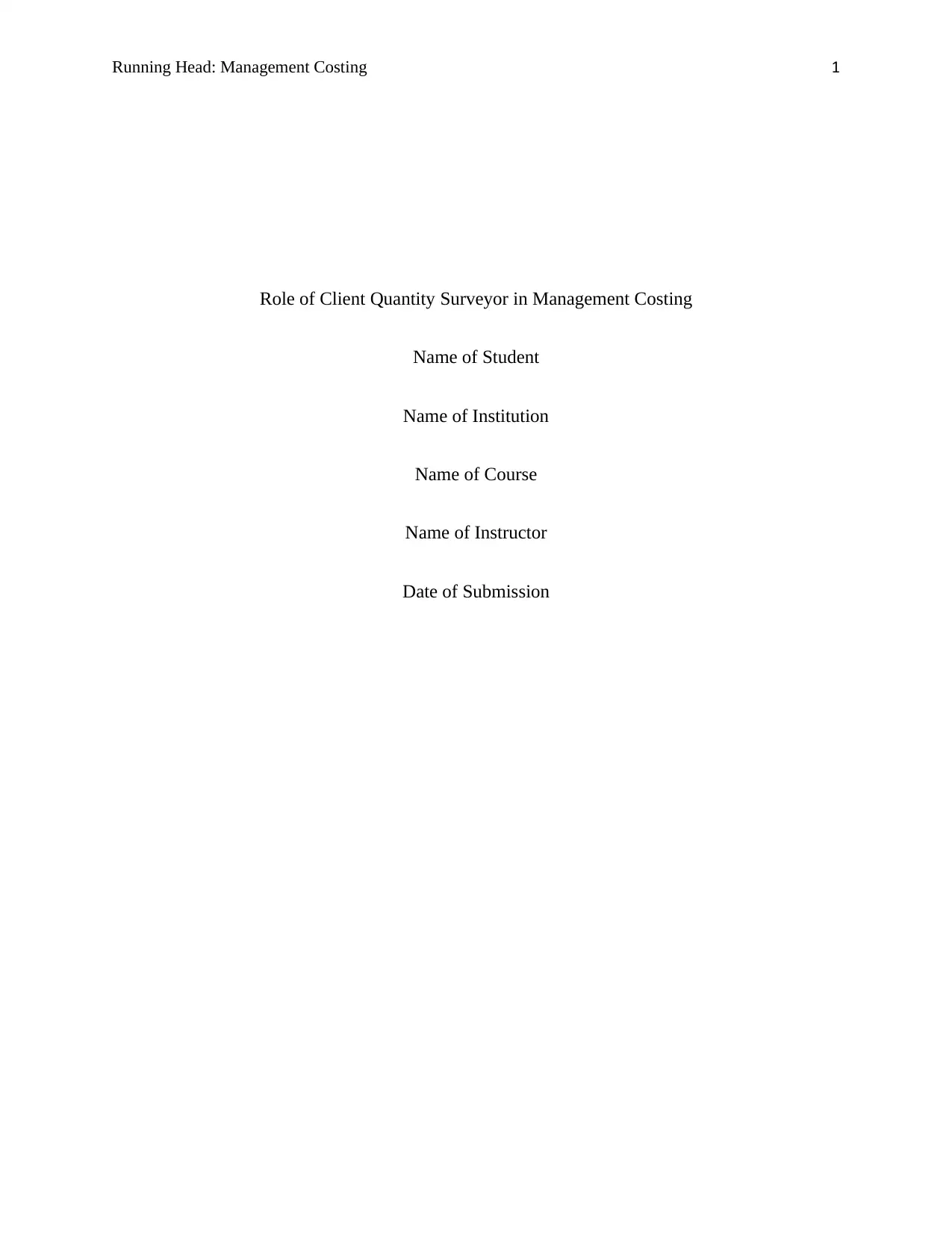
Running Head: Management Costing 1
Role of Client Quantity Surveyor in Management Costing
Name of Student
Name of Institution
Name of Course
Name of Instructor
Date of Submission
Role of Client Quantity Surveyor in Management Costing
Name of Student
Name of Institution
Name of Course
Name of Instructor
Date of Submission
Paraphrase This Document
Need a fresh take? Get an instant paraphrase of this document with our AI Paraphraser
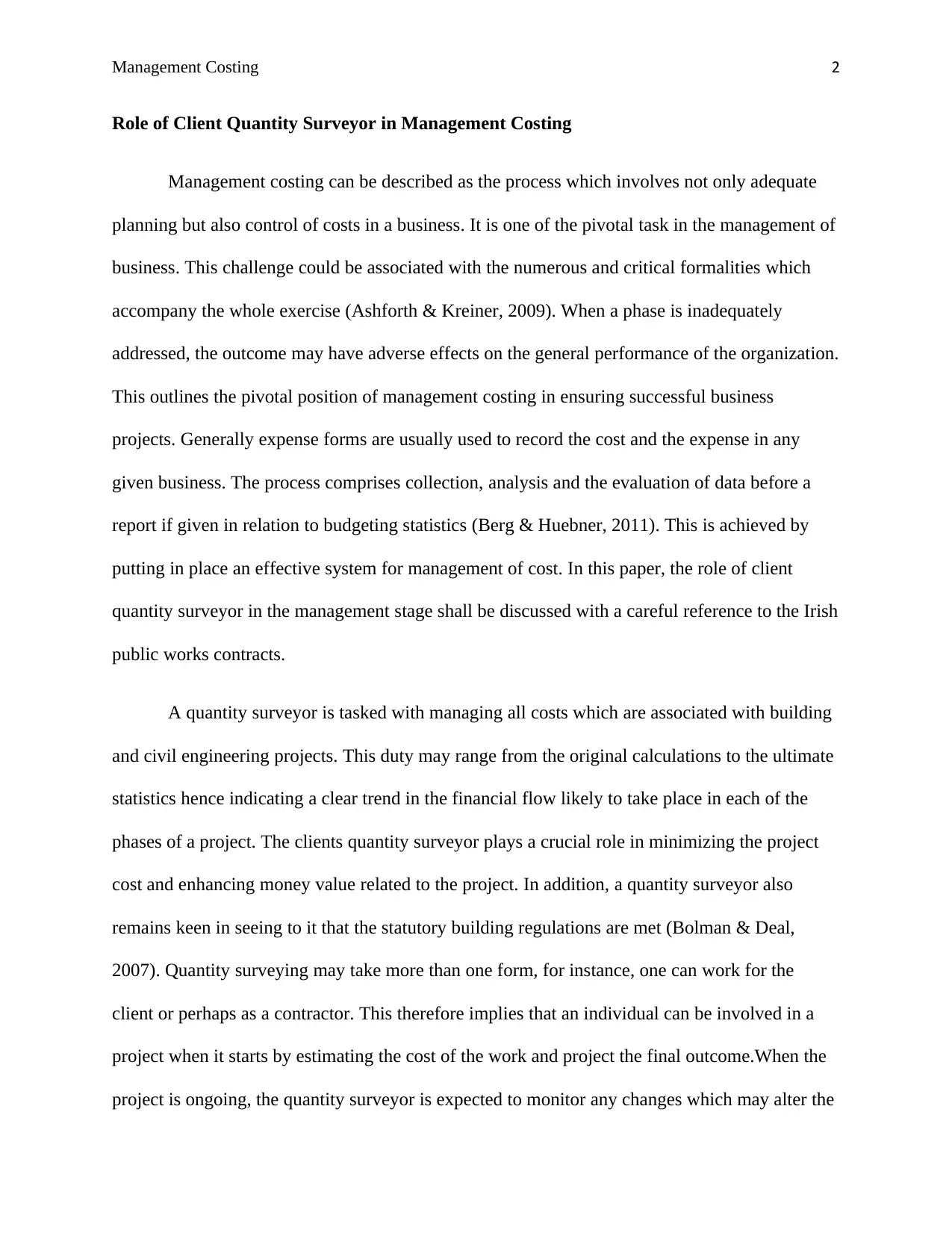
Management Costing 2
Role of Client Quantity Surveyor in Management Costing
Management costing can be described as the process which involves not only adequate
planning but also control of costs in a business. It is one of the pivotal task in the management of
business. This challenge could be associated with the numerous and critical formalities which
accompany the whole exercise (Ashforth & Kreiner, 2009). When a phase is inadequately
addressed, the outcome may have adverse effects on the general performance of the organization.
This outlines the pivotal position of management costing in ensuring successful business
projects. Generally expense forms are usually used to record the cost and the expense in any
given business. The process comprises collection, analysis and the evaluation of data before a
report if given in relation to budgeting statistics (Berg & Huebner, 2011). This is achieved by
putting in place an effective system for management of cost. In this paper, the role of client
quantity surveyor in the management stage shall be discussed with a careful reference to the Irish
public works contracts.
A quantity surveyor is tasked with managing all costs which are associated with building
and civil engineering projects. This duty may range from the original calculations to the ultimate
statistics hence indicating a clear trend in the financial flow likely to take place in each of the
phases of a project. The clients quantity surveyor plays a crucial role in minimizing the project
cost and enhancing money value related to the project. In addition, a quantity surveyor also
remains keen in seeing to it that the statutory building regulations are met (Bolman & Deal,
2007). Quantity surveying may take more than one form, for instance, one can work for the
client or perhaps as a contractor. This therefore implies that an individual can be involved in a
project when it starts by estimating the cost of the work and project the final outcome.When the
project is ongoing, the quantity surveyor is expected to monitor any changes which may alter the
Role of Client Quantity Surveyor in Management Costing
Management costing can be described as the process which involves not only adequate
planning but also control of costs in a business. It is one of the pivotal task in the management of
business. This challenge could be associated with the numerous and critical formalities which
accompany the whole exercise (Ashforth & Kreiner, 2009). When a phase is inadequately
addressed, the outcome may have adverse effects on the general performance of the organization.
This outlines the pivotal position of management costing in ensuring successful business
projects. Generally expense forms are usually used to record the cost and the expense in any
given business. The process comprises collection, analysis and the evaluation of data before a
report if given in relation to budgeting statistics (Berg & Huebner, 2011). This is achieved by
putting in place an effective system for management of cost. In this paper, the role of client
quantity surveyor in the management stage shall be discussed with a careful reference to the Irish
public works contracts.
A quantity surveyor is tasked with managing all costs which are associated with building
and civil engineering projects. This duty may range from the original calculations to the ultimate
statistics hence indicating a clear trend in the financial flow likely to take place in each of the
phases of a project. The clients quantity surveyor plays a crucial role in minimizing the project
cost and enhancing money value related to the project. In addition, a quantity surveyor also
remains keen in seeing to it that the statutory building regulations are met (Bolman & Deal,
2007). Quantity surveying may take more than one form, for instance, one can work for the
client or perhaps as a contractor. This therefore implies that an individual can be involved in a
project when it starts by estimating the cost of the work and project the final outcome.When the
project is ongoing, the quantity surveyor is expected to monitor any changes which may alter the
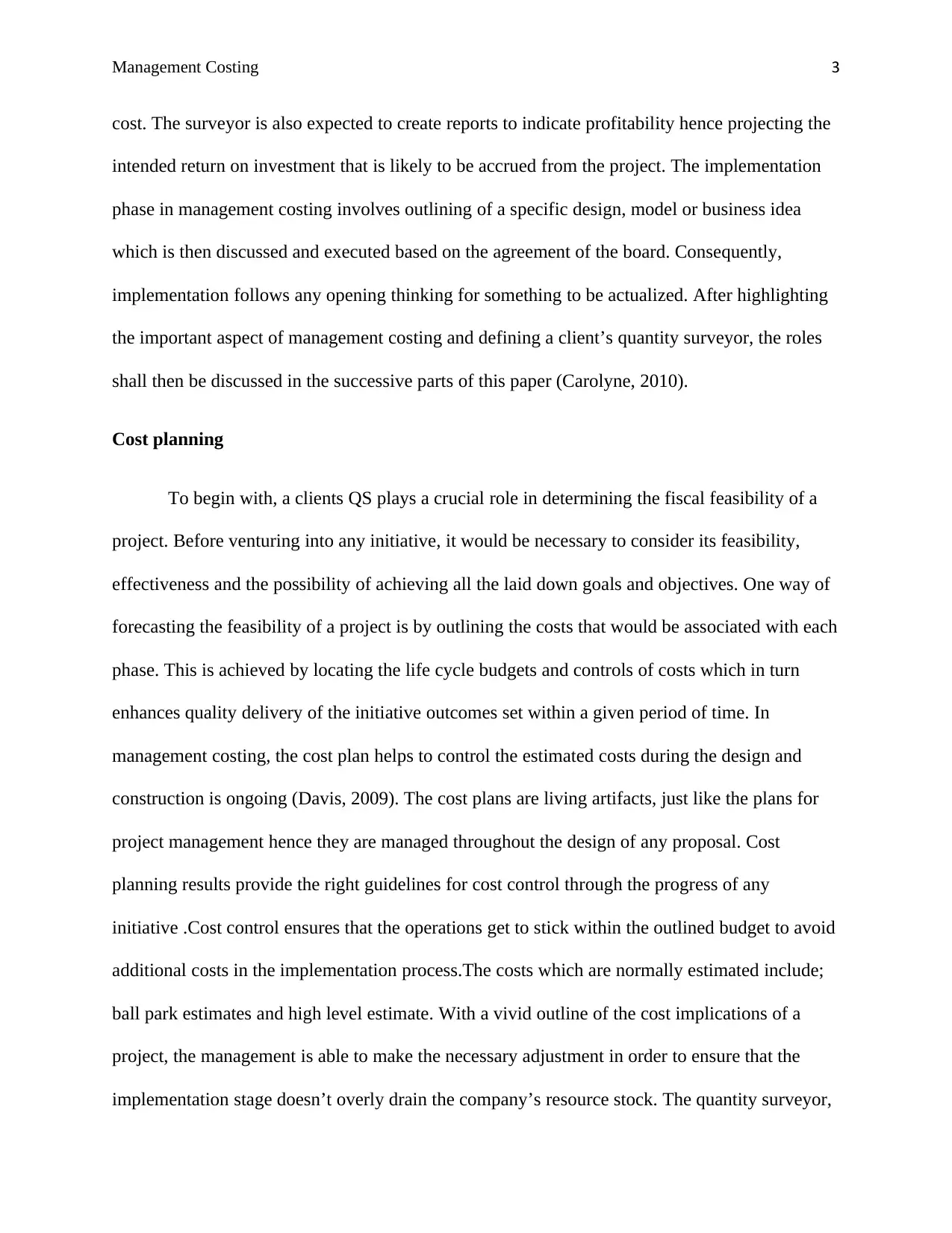
Management Costing 3
cost. The surveyor is also expected to create reports to indicate profitability hence projecting the
intended return on investment that is likely to be accrued from the project. The implementation
phase in management costing involves outlining of a specific design, model or business idea
which is then discussed and executed based on the agreement of the board. Consequently,
implementation follows any opening thinking for something to be actualized. After highlighting
the important aspect of management costing and defining a client’s quantity surveyor, the roles
shall then be discussed in the successive parts of this paper (Carolyne, 2010).
Cost planning
To begin with, a clients QS plays a crucial role in determining the fiscal feasibility of a
project. Before venturing into any initiative, it would be necessary to consider its feasibility,
effectiveness and the possibility of achieving all the laid down goals and objectives. One way of
forecasting the feasibility of a project is by outlining the costs that would be associated with each
phase. This is achieved by locating the life cycle budgets and controls of costs which in turn
enhances quality delivery of the initiative outcomes set within a given period of time. In
management costing, the cost plan helps to control the estimated costs during the design and
construction is ongoing (Davis, 2009). The cost plans are living artifacts, just like the plans for
project management hence they are managed throughout the design of any proposal. Cost
planning results provide the right guidelines for cost control through the progress of any
initiative .Cost control ensures that the operations get to stick within the outlined budget to avoid
additional costs in the implementation process.The costs which are normally estimated include;
ball park estimates and high level estimate. With a vivid outline of the cost implications of a
project, the management is able to make the necessary adjustment in order to ensure that the
implementation stage doesn’t overly drain the company’s resource stock. The quantity surveyor,
cost. The surveyor is also expected to create reports to indicate profitability hence projecting the
intended return on investment that is likely to be accrued from the project. The implementation
phase in management costing involves outlining of a specific design, model or business idea
which is then discussed and executed based on the agreement of the board. Consequently,
implementation follows any opening thinking for something to be actualized. After highlighting
the important aspect of management costing and defining a client’s quantity surveyor, the roles
shall then be discussed in the successive parts of this paper (Carolyne, 2010).
Cost planning
To begin with, a clients QS plays a crucial role in determining the fiscal feasibility of a
project. Before venturing into any initiative, it would be necessary to consider its feasibility,
effectiveness and the possibility of achieving all the laid down goals and objectives. One way of
forecasting the feasibility of a project is by outlining the costs that would be associated with each
phase. This is achieved by locating the life cycle budgets and controls of costs which in turn
enhances quality delivery of the initiative outcomes set within a given period of time. In
management costing, the cost plan helps to control the estimated costs during the design and
construction is ongoing (Davis, 2009). The cost plans are living artifacts, just like the plans for
project management hence they are managed throughout the design of any proposal. Cost
planning results provide the right guidelines for cost control through the progress of any
initiative .Cost control ensures that the operations get to stick within the outlined budget to avoid
additional costs in the implementation process.The costs which are normally estimated include;
ball park estimates and high level estimate. With a vivid outline of the cost implications of a
project, the management is able to make the necessary adjustment in order to ensure that the
implementation stage doesn’t overly drain the company’s resource stock. The quantity surveyor,
⊘ This is a preview!⊘
Do you want full access?
Subscribe today to unlock all pages.

Trusted by 1+ million students worldwide
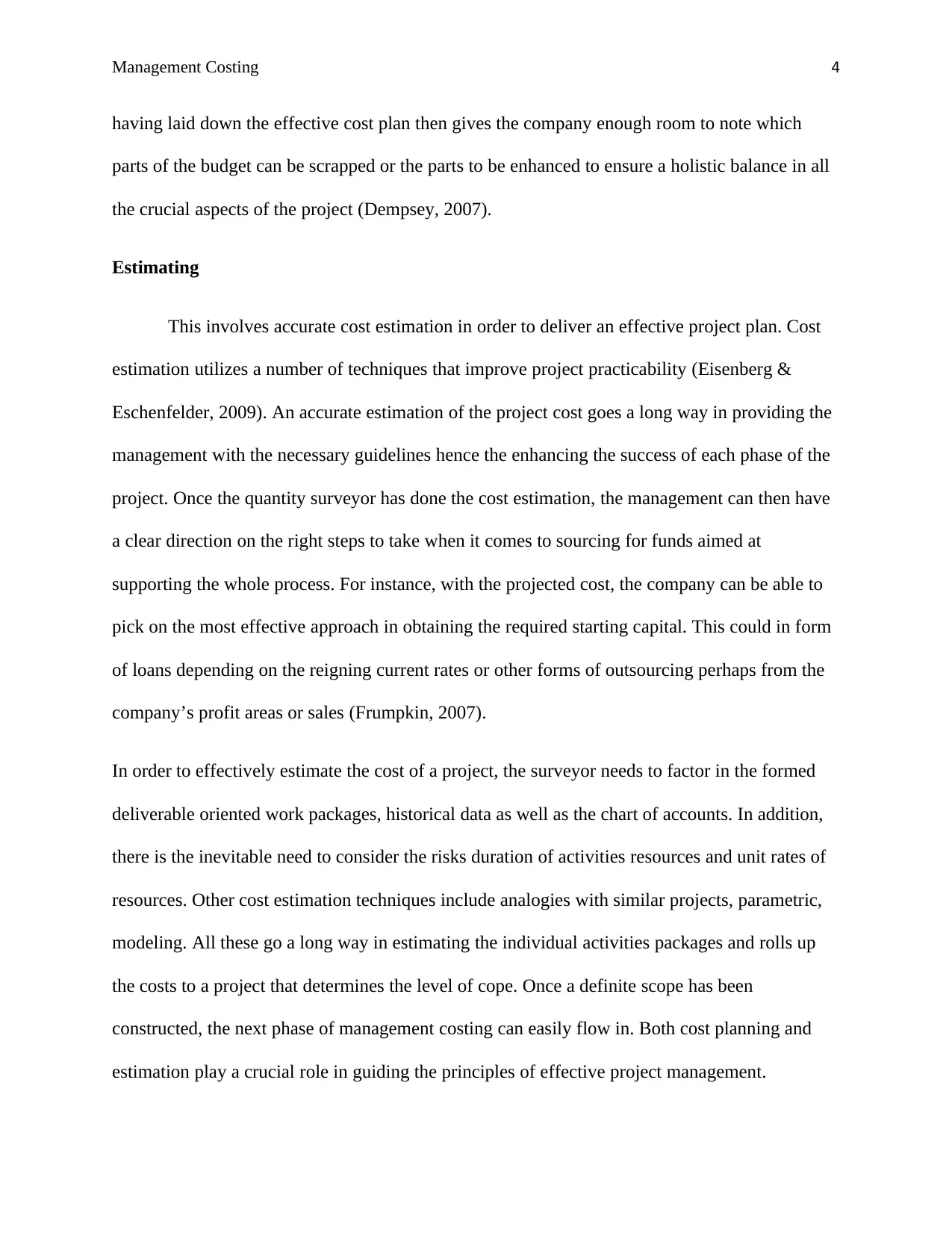
Management Costing 4
having laid down the effective cost plan then gives the company enough room to note which
parts of the budget can be scrapped or the parts to be enhanced to ensure a holistic balance in all
the crucial aspects of the project (Dempsey, 2007).
Estimating
This involves accurate cost estimation in order to deliver an effective project plan. Cost
estimation utilizes a number of techniques that improve project practicability (Eisenberg &
Eschenfelder, 2009). An accurate estimation of the project cost goes a long way in providing the
management with the necessary guidelines hence the enhancing the success of each phase of the
project. Once the quantity surveyor has done the cost estimation, the management can then have
a clear direction on the right steps to take when it comes to sourcing for funds aimed at
supporting the whole process. For instance, with the projected cost, the company can be able to
pick on the most effective approach in obtaining the required starting capital. This could in form
of loans depending on the reigning current rates or other forms of outsourcing perhaps from the
company’s profit areas or sales (Frumpkin, 2007).
In order to effectively estimate the cost of a project, the surveyor needs to factor in the formed
deliverable oriented work packages, historical data as well as the chart of accounts. In addition,
there is the inevitable need to consider the risks duration of activities resources and unit rates of
resources. Other cost estimation techniques include analogies with similar projects, parametric,
modeling. All these go a long way in estimating the individual activities packages and rolls up
the costs to a project that determines the level of cope. Once a definite scope has been
constructed, the next phase of management costing can easily flow in. Both cost planning and
estimation play a crucial role in guiding the principles of effective project management.
having laid down the effective cost plan then gives the company enough room to note which
parts of the budget can be scrapped or the parts to be enhanced to ensure a holistic balance in all
the crucial aspects of the project (Dempsey, 2007).
Estimating
This involves accurate cost estimation in order to deliver an effective project plan. Cost
estimation utilizes a number of techniques that improve project practicability (Eisenberg &
Eschenfelder, 2009). An accurate estimation of the project cost goes a long way in providing the
management with the necessary guidelines hence the enhancing the success of each phase of the
project. Once the quantity surveyor has done the cost estimation, the management can then have
a clear direction on the right steps to take when it comes to sourcing for funds aimed at
supporting the whole process. For instance, with the projected cost, the company can be able to
pick on the most effective approach in obtaining the required starting capital. This could in form
of loans depending on the reigning current rates or other forms of outsourcing perhaps from the
company’s profit areas or sales (Frumpkin, 2007).
In order to effectively estimate the cost of a project, the surveyor needs to factor in the formed
deliverable oriented work packages, historical data as well as the chart of accounts. In addition,
there is the inevitable need to consider the risks duration of activities resources and unit rates of
resources. Other cost estimation techniques include analogies with similar projects, parametric,
modeling. All these go a long way in estimating the individual activities packages and rolls up
the costs to a project that determines the level of cope. Once a definite scope has been
constructed, the next phase of management costing can easily flow in. Both cost planning and
estimation play a crucial role in guiding the principles of effective project management.
Paraphrase This Document
Need a fresh take? Get an instant paraphrase of this document with our AI Paraphraser
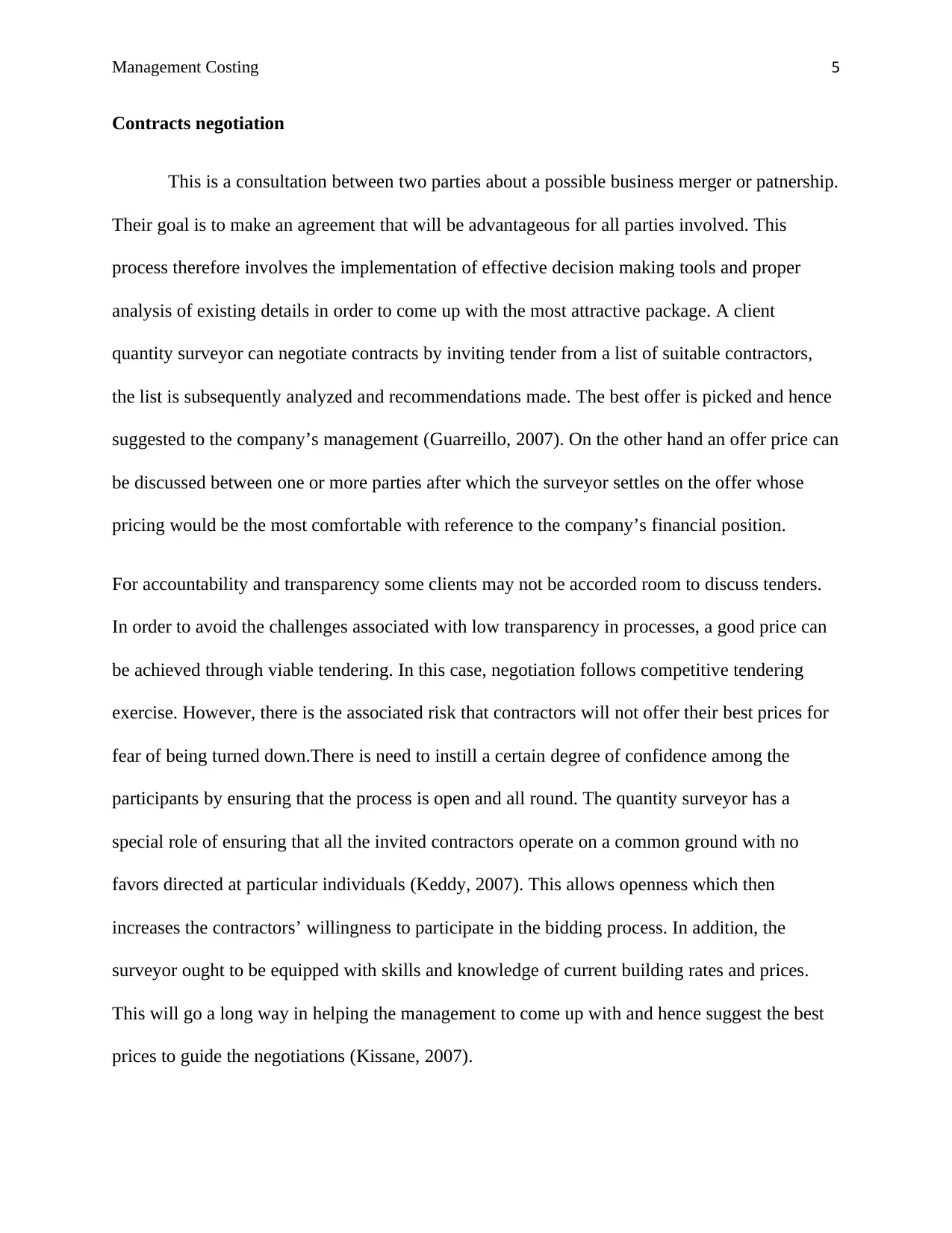
Management Costing 5
Contracts negotiation
This is a consultation between two parties about a possible business merger or patnership.
Their goal is to make an agreement that will be advantageous for all parties involved. This
process therefore involves the implementation of effective decision making tools and proper
analysis of existing details in order to come up with the most attractive package. A client
quantity surveyor can negotiate contracts by inviting tender from a list of suitable contractors,
the list is subsequently analyzed and recommendations made. The best offer is picked and hence
suggested to the company’s management (Guarreillo, 2007). On the other hand an offer price can
be discussed between one or more parties after which the surveyor settles on the offer whose
pricing would be the most comfortable with reference to the company’s financial position.
For accountability and transparency some clients may not be accorded room to discuss tenders.
In order to avoid the challenges associated with low transparency in processes, a good price can
be achieved through viable tendering. In this case, negotiation follows competitive tendering
exercise. However, there is the associated risk that contractors will not offer their best prices for
fear of being turned down.There is need to instill a certain degree of confidence among the
participants by ensuring that the process is open and all round. The quantity surveyor has a
special role of ensuring that all the invited contractors operate on a common ground with no
favors directed at particular individuals (Keddy, 2007). This allows openness which then
increases the contractors’ willingness to participate in the bidding process. In addition, the
surveyor ought to be equipped with skills and knowledge of current building rates and prices.
This will go a long way in helping the management to come up with and hence suggest the best
prices to guide the negotiations (Kissane, 2007).
Contracts negotiation
This is a consultation between two parties about a possible business merger or patnership.
Their goal is to make an agreement that will be advantageous for all parties involved. This
process therefore involves the implementation of effective decision making tools and proper
analysis of existing details in order to come up with the most attractive package. A client
quantity surveyor can negotiate contracts by inviting tender from a list of suitable contractors,
the list is subsequently analyzed and recommendations made. The best offer is picked and hence
suggested to the company’s management (Guarreillo, 2007). On the other hand an offer price can
be discussed between one or more parties after which the surveyor settles on the offer whose
pricing would be the most comfortable with reference to the company’s financial position.
For accountability and transparency some clients may not be accorded room to discuss tenders.
In order to avoid the challenges associated with low transparency in processes, a good price can
be achieved through viable tendering. In this case, negotiation follows competitive tendering
exercise. However, there is the associated risk that contractors will not offer their best prices for
fear of being turned down.There is need to instill a certain degree of confidence among the
participants by ensuring that the process is open and all round. The quantity surveyor has a
special role of ensuring that all the invited contractors operate on a common ground with no
favors directed at particular individuals (Keddy, 2007). This allows openness which then
increases the contractors’ willingness to participate in the bidding process. In addition, the
surveyor ought to be equipped with skills and knowledge of current building rates and prices.
This will go a long way in helping the management to come up with and hence suggest the best
prices to guide the negotiations (Kissane, 2007).
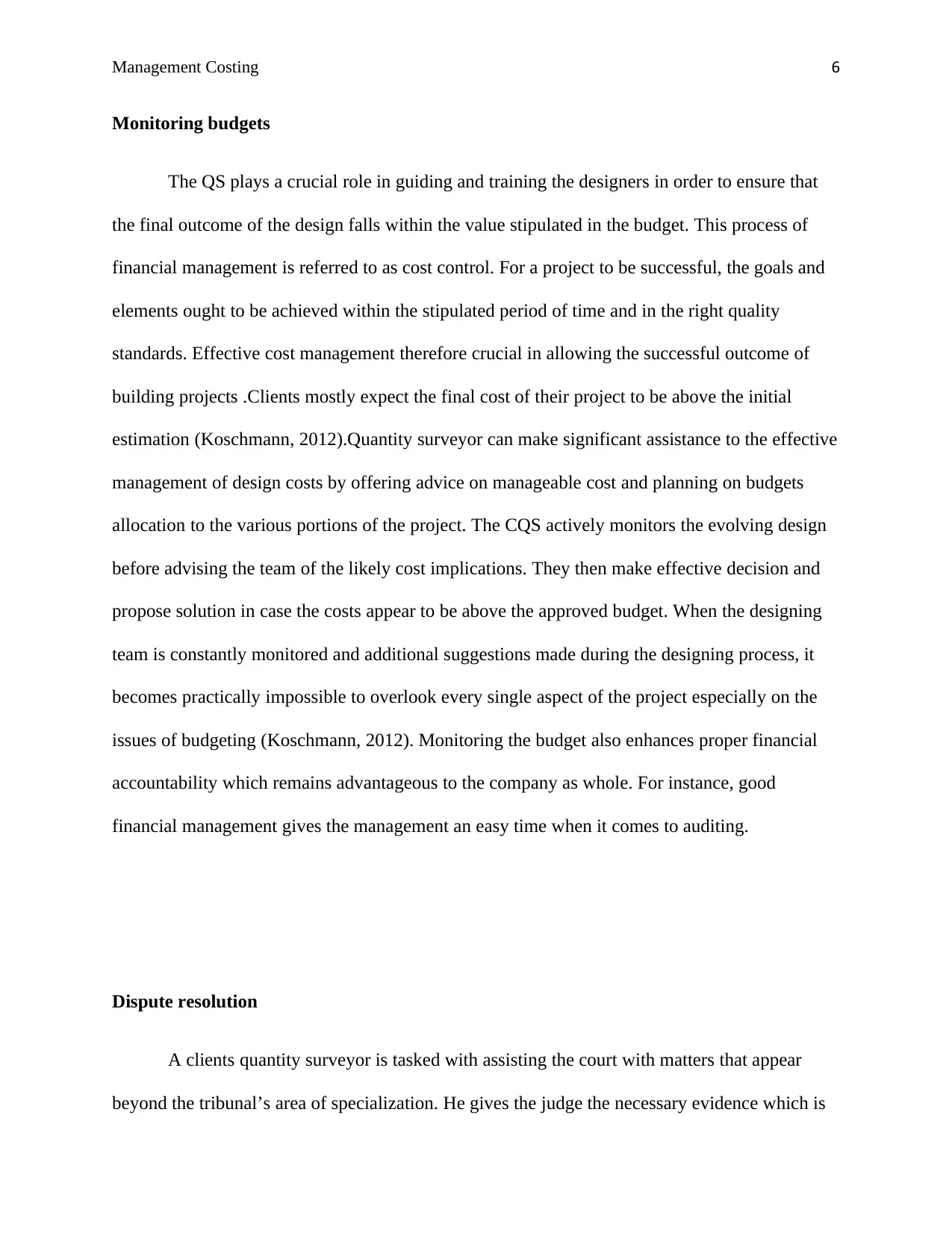
Management Costing 6
Monitoring budgets
The QS plays a crucial role in guiding and training the designers in order to ensure that
the final outcome of the design falls within the value stipulated in the budget. This process of
financial management is referred to as cost control. For a project to be successful, the goals and
elements ought to be achieved within the stipulated period of time and in the right quality
standards. Effective cost management therefore crucial in allowing the successful outcome of
building projects .Clients mostly expect the final cost of their project to be above the initial
estimation (Koschmann, 2012).Quantity surveyor can make significant assistance to the effective
management of design costs by offering advice on manageable cost and planning on budgets
allocation to the various portions of the project. The CQS actively monitors the evolving design
before advising the team of the likely cost implications. They then make effective decision and
propose solution in case the costs appear to be above the approved budget. When the designing
team is constantly monitored and additional suggestions made during the designing process, it
becomes practically impossible to overlook every single aspect of the project especially on the
issues of budgeting (Koschmann, 2012). Monitoring the budget also enhances proper financial
accountability which remains advantageous to the company as whole. For instance, good
financial management gives the management an easy time when it comes to auditing.
Dispute resolution
A clients quantity surveyor is tasked with assisting the court with matters that appear
beyond the tribunal’s area of specialization. He gives the judge the necessary evidence which is
Monitoring budgets
The QS plays a crucial role in guiding and training the designers in order to ensure that
the final outcome of the design falls within the value stipulated in the budget. This process of
financial management is referred to as cost control. For a project to be successful, the goals and
elements ought to be achieved within the stipulated period of time and in the right quality
standards. Effective cost management therefore crucial in allowing the successful outcome of
building projects .Clients mostly expect the final cost of their project to be above the initial
estimation (Koschmann, 2012).Quantity surveyor can make significant assistance to the effective
management of design costs by offering advice on manageable cost and planning on budgets
allocation to the various portions of the project. The CQS actively monitors the evolving design
before advising the team of the likely cost implications. They then make effective decision and
propose solution in case the costs appear to be above the approved budget. When the designing
team is constantly monitored and additional suggestions made during the designing process, it
becomes practically impossible to overlook every single aspect of the project especially on the
issues of budgeting (Koschmann, 2012). Monitoring the budget also enhances proper financial
accountability which remains advantageous to the company as whole. For instance, good
financial management gives the management an easy time when it comes to auditing.
Dispute resolution
A clients quantity surveyor is tasked with assisting the court with matters that appear
beyond the tribunal’s area of specialization. He gives the judge the necessary evidence which is
⊘ This is a preview!⊘
Do you want full access?
Subscribe today to unlock all pages.

Trusted by 1+ million students worldwide
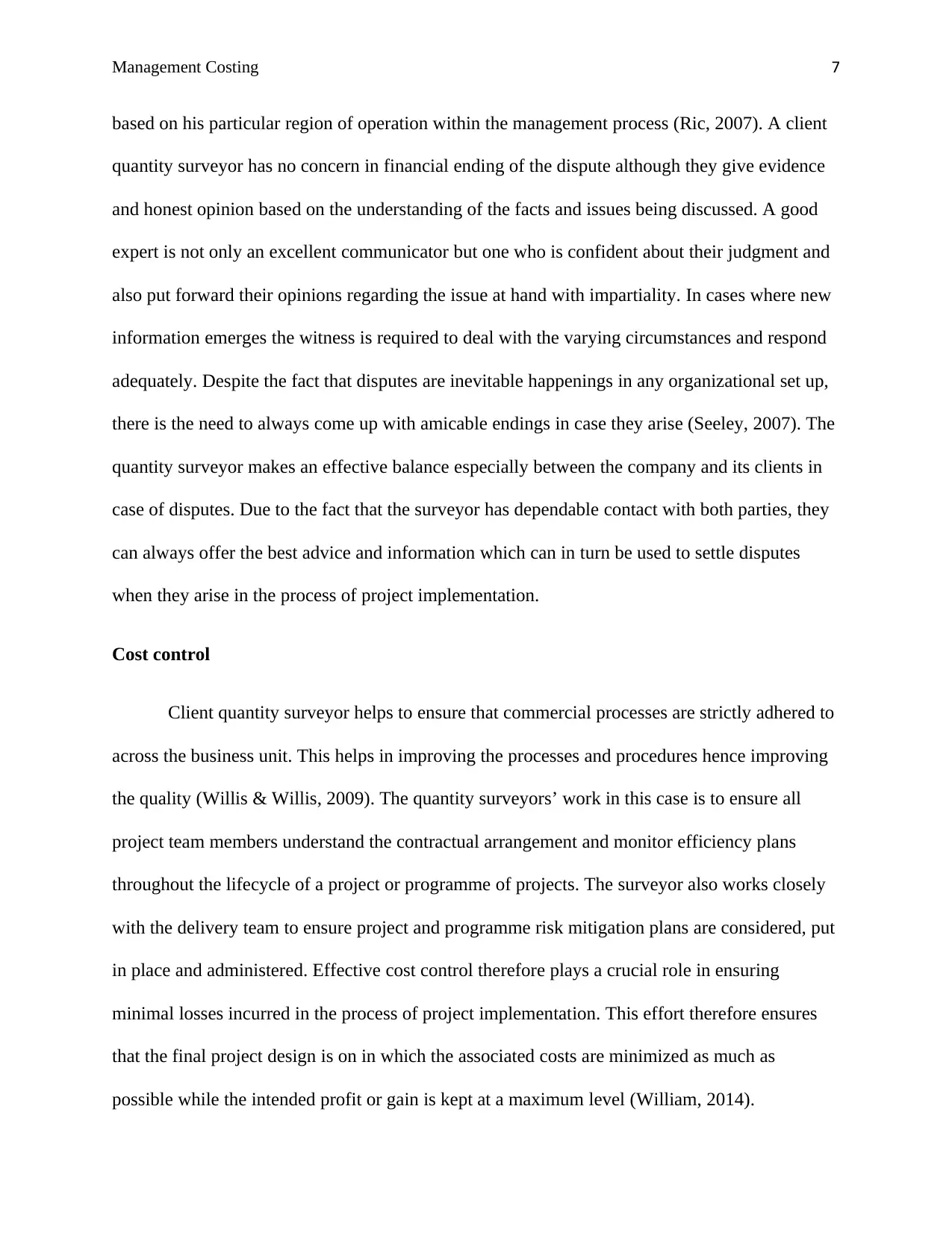
Management Costing 7
based on his particular region of operation within the management process (Ric, 2007). A client
quantity surveyor has no concern in financial ending of the dispute although they give evidence
and honest opinion based on the understanding of the facts and issues being discussed. A good
expert is not only an excellent communicator but one who is confident about their judgment and
also put forward their opinions regarding the issue at hand with impartiality. In cases where new
information emerges the witness is required to deal with the varying circumstances and respond
adequately. Despite the fact that disputes are inevitable happenings in any organizational set up,
there is the need to always come up with amicable endings in case they arise (Seeley, 2007). The
quantity surveyor makes an effective balance especially between the company and its clients in
case of disputes. Due to the fact that the surveyor has dependable contact with both parties, they
can always offer the best advice and information which can in turn be used to settle disputes
when they arise in the process of project implementation.
Cost control
Client quantity surveyor helps to ensure that commercial processes are strictly adhered to
across the business unit. This helps in improving the processes and procedures hence improving
the quality (Willis & Willis, 2009). The quantity surveyors’ work in this case is to ensure all
project team members understand the contractual arrangement and monitor efficiency plans
throughout the lifecycle of a project or programme of projects. The surveyor also works closely
with the delivery team to ensure project and programme risk mitigation plans are considered, put
in place and administered. Effective cost control therefore plays a crucial role in ensuring
minimal losses incurred in the process of project implementation. This effort therefore ensures
that the final project design is on in which the associated costs are minimized as much as
possible while the intended profit or gain is kept at a maximum level (William, 2014).
based on his particular region of operation within the management process (Ric, 2007). A client
quantity surveyor has no concern in financial ending of the dispute although they give evidence
and honest opinion based on the understanding of the facts and issues being discussed. A good
expert is not only an excellent communicator but one who is confident about their judgment and
also put forward their opinions regarding the issue at hand with impartiality. In cases where new
information emerges the witness is required to deal with the varying circumstances and respond
adequately. Despite the fact that disputes are inevitable happenings in any organizational set up,
there is the need to always come up with amicable endings in case they arise (Seeley, 2007). The
quantity surveyor makes an effective balance especially between the company and its clients in
case of disputes. Due to the fact that the surveyor has dependable contact with both parties, they
can always offer the best advice and information which can in turn be used to settle disputes
when they arise in the process of project implementation.
Cost control
Client quantity surveyor helps to ensure that commercial processes are strictly adhered to
across the business unit. This helps in improving the processes and procedures hence improving
the quality (Willis & Willis, 2009). The quantity surveyors’ work in this case is to ensure all
project team members understand the contractual arrangement and monitor efficiency plans
throughout the lifecycle of a project or programme of projects. The surveyor also works closely
with the delivery team to ensure project and programme risk mitigation plans are considered, put
in place and administered. Effective cost control therefore plays a crucial role in ensuring
minimal losses incurred in the process of project implementation. This effort therefore ensures
that the final project design is on in which the associated costs are minimized as much as
possible while the intended profit or gain is kept at a maximum level (William, 2014).
Paraphrase This Document
Need a fresh take? Get an instant paraphrase of this document with our AI Paraphraser
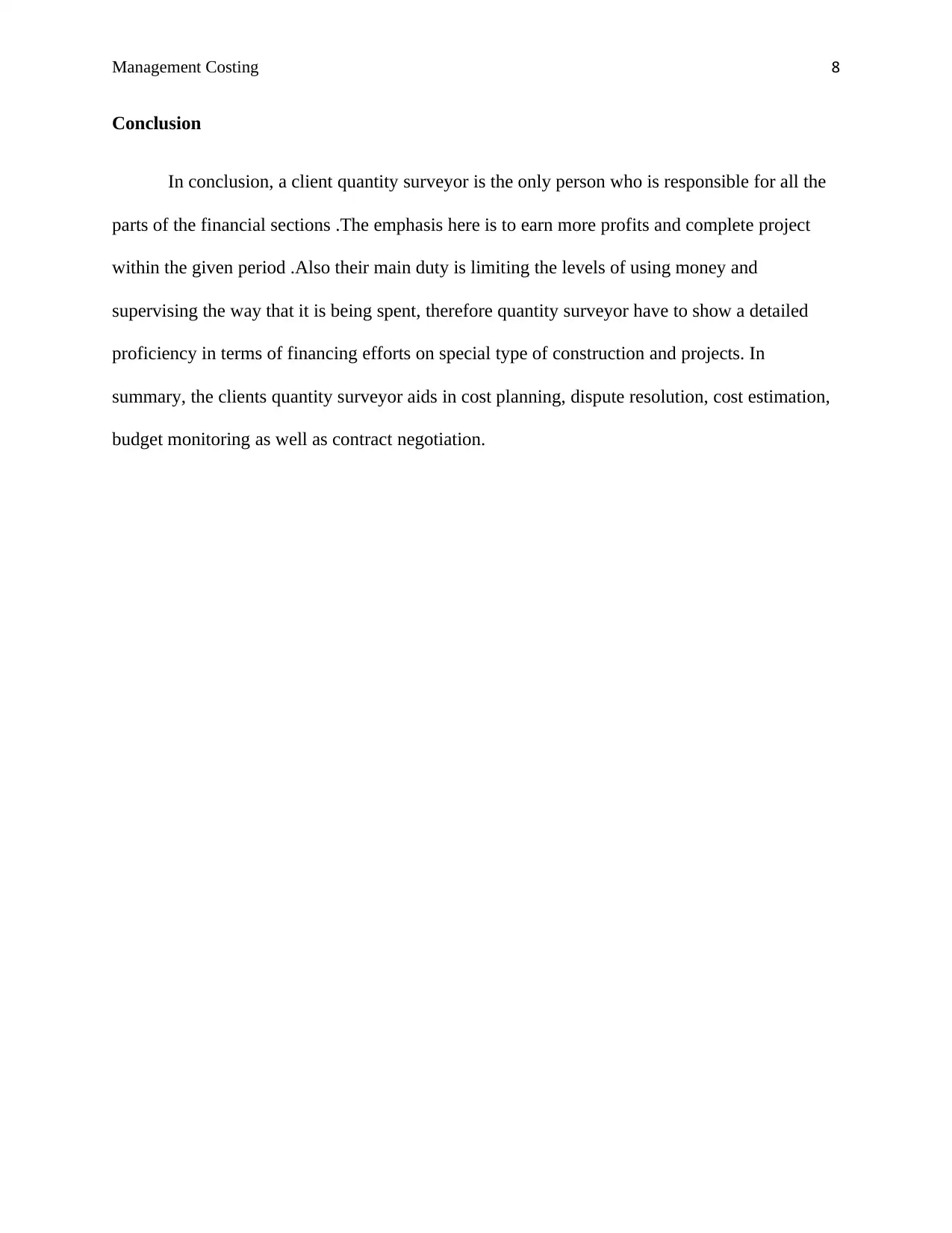
Management Costing 8
Conclusion
In conclusion, a client quantity surveyor is the only person who is responsible for all the
parts of the financial sections .The emphasis here is to earn more profits and complete project
within the given period .Also their main duty is limiting the levels of using money and
supervising the way that it is being spent, therefore quantity surveyor have to show a detailed
proficiency in terms of financing efforts on special type of construction and projects. In
summary, the clients quantity surveyor aids in cost planning, dispute resolution, cost estimation,
budget monitoring as well as contract negotiation.
Conclusion
In conclusion, a client quantity surveyor is the only person who is responsible for all the
parts of the financial sections .The emphasis here is to earn more profits and complete project
within the given period .Also their main duty is limiting the levels of using money and
supervising the way that it is being spent, therefore quantity surveyor have to show a detailed
proficiency in terms of financing efforts on special type of construction and projects. In
summary, the clients quantity surveyor aids in cost planning, dispute resolution, cost estimation,
budget monitoring as well as contract negotiation.
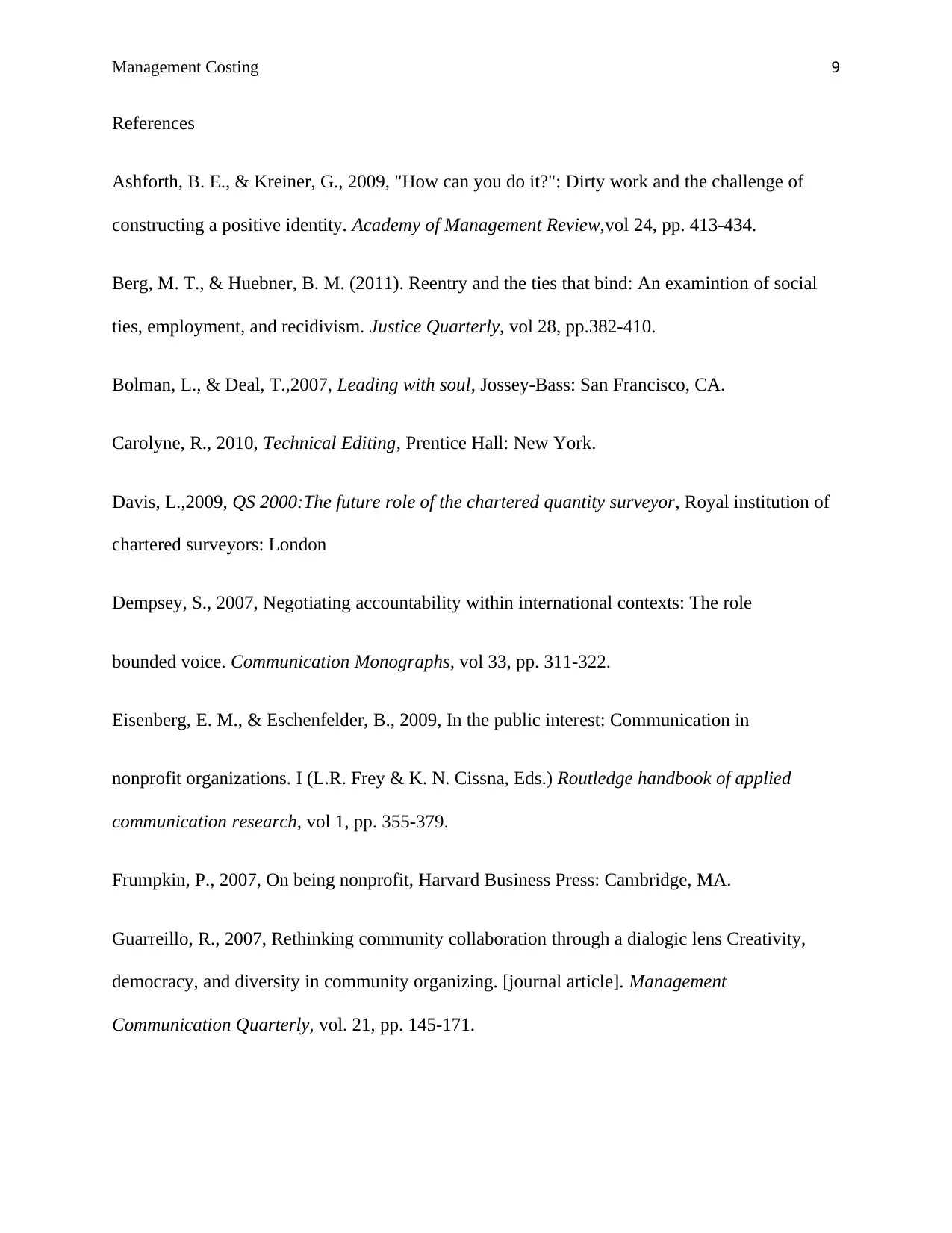
Management Costing 9
References
Ashforth, B. E., & Kreiner, G., 2009, "How can you do it?": Dirty work and the challenge of
constructing a positive identity. Academy of Management Review,vol 24, pp. 413-434.
Berg, M. T., & Huebner, B. M. (2011). Reentry and the ties that bind: An examintion of social
ties, employment, and recidivism. Justice Quarterly, vol 28, pp.382-410.
Bolman, L., & Deal, T.,2007, Leading with soul, Jossey-Bass: San Francisco, CA.
Carolyne, R., 2010, Technical Editing, Prentice Hall: New York.
Davis, L.,2009, QS 2000:The future role of the chartered quantity surveyor, Royal institution of
chartered surveyors: London
Dempsey, S., 2007, Negotiating accountability within international contexts: The role
bounded voice. Communication Monographs, vol 33, pp. 311-322.
Eisenberg, E. M., & Eschenfelder, B., 2009, In the public interest: Communication in
nonprofit organizations. I (L.R. Frey & K. N. Cissna, Eds.) Routledge handbook of applied
communication research, vol 1, pp. 355-379.
Frumpkin, P., 2007, On being nonprofit, Harvard Business Press: Cambridge, MA.
Guarreillo, R., 2007, Rethinking community collaboration through a dialogic lens Creativity,
democracy, and diversity in community organizing. [journal article]. Management
Communication Quarterly, vol. 21, pp. 145-171.
References
Ashforth, B. E., & Kreiner, G., 2009, "How can you do it?": Dirty work and the challenge of
constructing a positive identity. Academy of Management Review,vol 24, pp. 413-434.
Berg, M. T., & Huebner, B. M. (2011). Reentry and the ties that bind: An examintion of social
ties, employment, and recidivism. Justice Quarterly, vol 28, pp.382-410.
Bolman, L., & Deal, T.,2007, Leading with soul, Jossey-Bass: San Francisco, CA.
Carolyne, R., 2010, Technical Editing, Prentice Hall: New York.
Davis, L.,2009, QS 2000:The future role of the chartered quantity surveyor, Royal institution of
chartered surveyors: London
Dempsey, S., 2007, Negotiating accountability within international contexts: The role
bounded voice. Communication Monographs, vol 33, pp. 311-322.
Eisenberg, E. M., & Eschenfelder, B., 2009, In the public interest: Communication in
nonprofit organizations. I (L.R. Frey & K. N. Cissna, Eds.) Routledge handbook of applied
communication research, vol 1, pp. 355-379.
Frumpkin, P., 2007, On being nonprofit, Harvard Business Press: Cambridge, MA.
Guarreillo, R., 2007, Rethinking community collaboration through a dialogic lens Creativity,
democracy, and diversity in community organizing. [journal article]. Management
Communication Quarterly, vol. 21, pp. 145-171.
⊘ This is a preview!⊘
Do you want full access?
Subscribe today to unlock all pages.

Trusted by 1+ million students worldwide
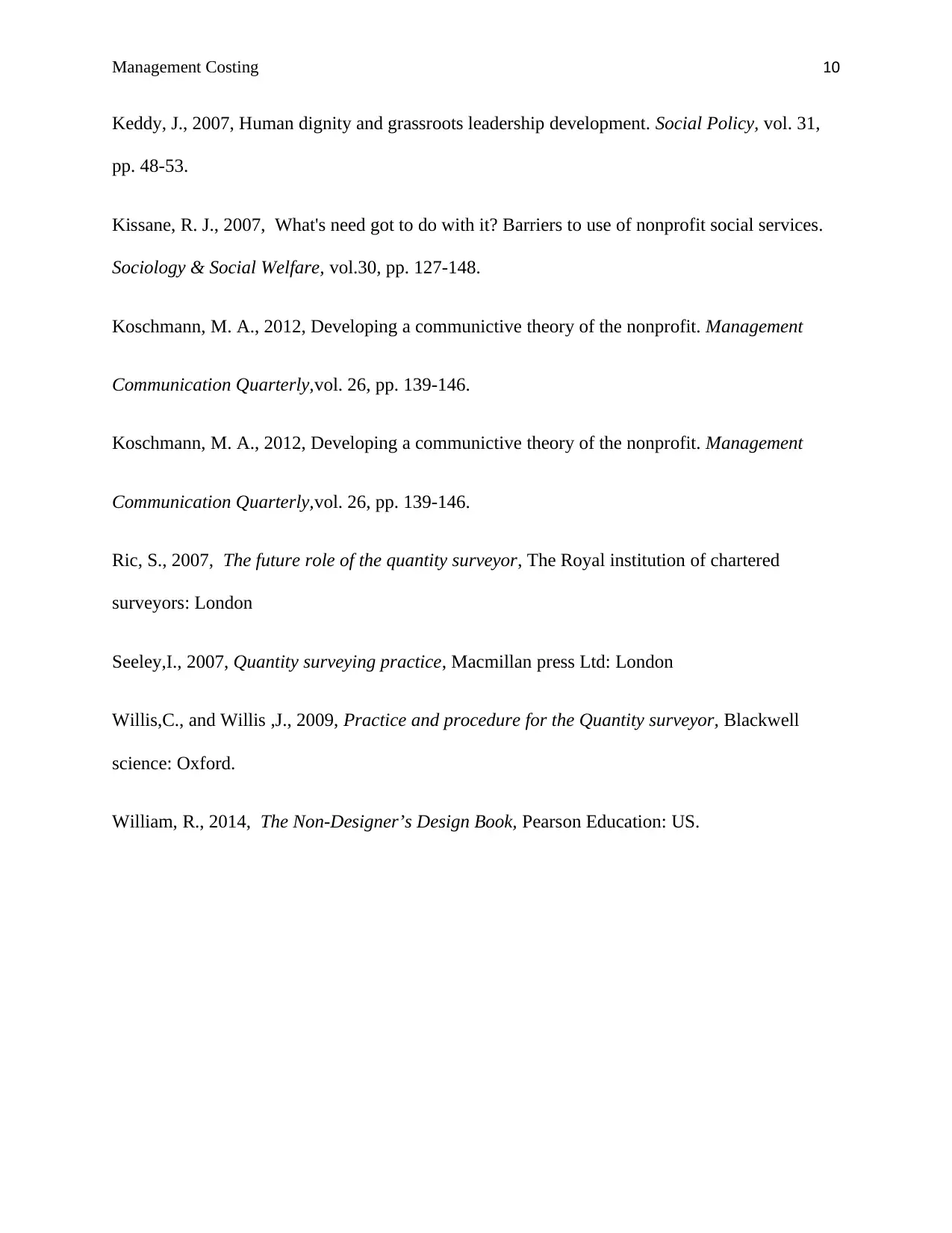
Management Costing 10
Keddy, J., 2007, Human dignity and grassroots leadership development. Social Policy, vol. 31,
pp. 48-53.
Kissane, R. J., 2007, What's need got to do with it? Barriers to use of nonprofit social services.
Sociology & Social Welfare, vol.30, pp. 127-148.
Koschmann, M. A., 2012, Developing a communictive theory of the nonprofit. Management
Communication Quarterly,vol. 26, pp. 139-146.
Koschmann, M. A., 2012, Developing a communictive theory of the nonprofit. Management
Communication Quarterly,vol. 26, pp. 139-146.
Ric, S., 2007, The future role of the quantity surveyor, The Royal institution of chartered
surveyors: London
Seeley,I., 2007, Quantity surveying practice, Macmillan press Ltd: London
Willis,C., and Willis ,J., 2009, Practice and procedure for the Quantity surveyor, Blackwell
science: Oxford.
William, R., 2014, The Non-Designer’s Design Book, Pearson Education: US.
Keddy, J., 2007, Human dignity and grassroots leadership development. Social Policy, vol. 31,
pp. 48-53.
Kissane, R. J., 2007, What's need got to do with it? Barriers to use of nonprofit social services.
Sociology & Social Welfare, vol.30, pp. 127-148.
Koschmann, M. A., 2012, Developing a communictive theory of the nonprofit. Management
Communication Quarterly,vol. 26, pp. 139-146.
Koschmann, M. A., 2012, Developing a communictive theory of the nonprofit. Management
Communication Quarterly,vol. 26, pp. 139-146.
Ric, S., 2007, The future role of the quantity surveyor, The Royal institution of chartered
surveyors: London
Seeley,I., 2007, Quantity surveying practice, Macmillan press Ltd: London
Willis,C., and Willis ,J., 2009, Practice and procedure for the Quantity surveyor, Blackwell
science: Oxford.
William, R., 2014, The Non-Designer’s Design Book, Pearson Education: US.
Paraphrase This Document
Need a fresh take? Get an instant paraphrase of this document with our AI Paraphraser

Management Costing 11
1 out of 11
Related Documents
Your All-in-One AI-Powered Toolkit for Academic Success.
+13062052269
info@desklib.com
Available 24*7 on WhatsApp / Email
![[object Object]](/_next/static/media/star-bottom.7253800d.svg)
Unlock your academic potential
Copyright © 2020–2025 A2Z Services. All Rights Reserved. Developed and managed by ZUCOL.





